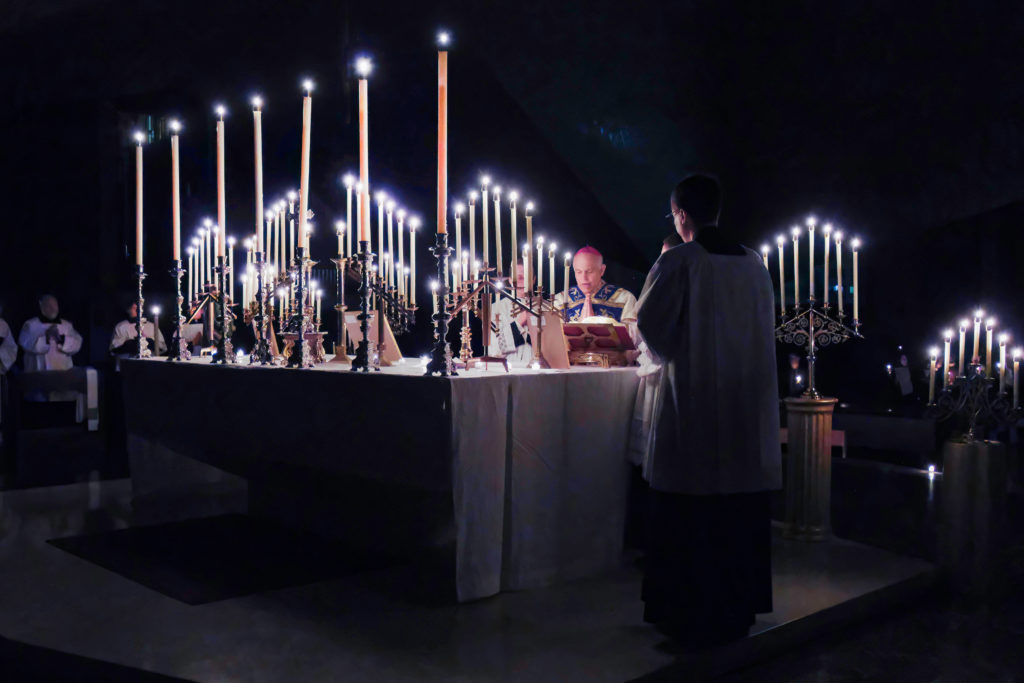Some parts of the Christian liturgy are so ancient that we just assume they grew organically all by themselves, like plants. But in fact, every single word of the liturgy is the work of an inventive human mind that somewhere, at some point in time, forged a prayer out of Scripture, very often music as well, and very often even older prayers. Such was the origin of the “O” Antiphons, the seven short prayers to the yet-unborn Christ that precede the recitation of the Magnificat in the Vespers, or Evening Prayer, liturgy of the Latin Church during the last days of Advent, from December 17 through December 23.
The O Antiphons, with their rich compression of images, are gems of human creativity poetic and musical. Exactly when and where they were composed is uncertain. They were chanted at the Benedictine abbey at Fleury, on the Loire River in central France, during the eighth century, although some scholars believe that they date to the fifth century or even earlier, since the Christian philosopher Boethius seemed to quote a phrase from the first O Antiphon in his treatise Consolation of Philosophy (A.D. 524). By the ninth century, the O Antiphons were part of the Vespers liturgy for Advent at monasteries and churches all over Western Europe, including Rome. The composer was clearly a man of learning, probably a monk, who knew the texts of the Latin Vulgate Bible intimately. Nearly all the words in each of the seven antiphons are direct quotations from or paraphrases of a huge range of Latin Scripture, mostly the Old Testament, since that was the time of waiting for the coming of the Messiah. Sources included the writings of Isaiah and other prophets, the “wisdom” books of the Old Testament (Wisdom, Proverbs, Sirach), the books of Genesis, Exodus, Leviticus, and Chronicles, the Gospels of Matthew and Luke, and the letters of Paul.
Since the O Antiphons were designed for antiphonal chanting (a cantor and a choir, or possibly two alternating choirs), each has two parts. The first part begins with the vocative “O” (hence the antiphons’ collective name) and a Scripture-derived title for Christ: “O Sapientia (O Wisdom),” “O Adonai (O Adonai, or Lord),” “O radix Jesse (O stock of Jesse),” “O clavis David (O key of David,” “O Oriens (O Dayspring, or rising sun),” “O Rex gentium” (O king of all peoples),” “O Emmanuel (O Emmanuel).” The second part begins with the word “veni (Come!),” evoking intense longing for the coming of Christ as Christmas draws near.
Here is a sample, the Latin text of the first O Antiphon, the one that Boethius might have quoted:
O Sapientia,
quae ex ore Altissimi prodiisti,
attingens a fine usque ad finem,
fortiter suaviterque disponens omnia:
veni ad docendum nos viam prudentiae.
Here is the English translation, from the iBreviary website:
O Wisdom,
You come forth from the mouth of the Most High.
You fill the universe and hold all things together
in a strong yet gentle manner.
O come teach us the way of truth.
Here is the Latin text of the seventh and final O Antiphon, for Vespers on December 23:
O Emmanuel,
Rex et legifer noster,
exspectatio gentium, et Salvator earum:
veni ad salvandum nos, Domine, Deus noster.
Here is the English translation from iBreviary:
O Emmanuel,
You are our king and judge
the One whom the peoples await, and their Savior.
O come and save us, Lord our God.
Together, the initial letters of Christ’s titles in Latin in all seven O Antiphons (S, A, R, C, O, R, and E), when read backwards, form an acrostic: ero cras, or “I shall be [with you] tomorrow.” Early-medieval writers delighted in acrostics, and this one pointed specifically to the birth of Christ at midnight on the night of Christmas Eve.
The O Antiphons—the “Great O’s”—have been so beloved over the centuries that they have generated their own waves of creativity among musicians, writers, and artists inspired by them. As the Middle Ages progressed, liturgists composed additional O antiphons for Advent; an “eighth” antiphon for Christmas Eve honoring Mary, “O virgo virginum (O Virgin of Virgins)” became standard in English churches and remains part of the Anglican Advent liturgy to this day. Some medieval churches and religious houses developed as many as twelve different O antiphons honoring saints, other titles of Christ, and even the holy city of Jerusalem. The post-Vatican II Catholic liturgy not only retains the original seven O Antiphons in Latin and vernacular Evening Prayer but incorporates shorter versions of their texts into the Alleluia of the daily Mass for December 17 through December 23.
Musical settings for the antiphons have proliferated, in Gregorian chant, of course, but also in Renaissance and Baroque polyphony (Josquin de Prez, Marc-Antoine Charpentier) and works by contemporary composers Arvo Pärt and James MacMillan. The most famous—and most familiar—musical adaptation of the O Antiphons, however, is the Advent favorite, “Veni, veni Emmanuel (O come, O come, Emmanuel),” which incorporates five of the seven, although in a different order. It is a hymn that sounds medieval (its music dates from the fifteenth century) but its Latin text was actually composed closer to the early eighteenth century. The standard English carol version that everyone knows and sings did not appear until 1851.
Some of the most creative works inspired by the O Antiphons have been extended meditations on their content and meaning, meditations that are works of literature in themselves. One of the first was a ninth-century Anglo-Saxon poem of 439 alliterative lines by an unknown author that literary scholars call Christ I. Its theme is Advent—scriptural history before Christ’s birth—it has twelve sections that are actually independent poems, and each of the sections is based upon an O antiphon, either one of the original seven or one of the many medieval extras. I recommend the blog A Clerk of Oxford, maintained by an anonymous scholar of Anglo-Saxon literature who has translated Christ I from its Old English original:
Now that child is come,
born to relieve the works of the Hebrews,
brings joy to you, unlooses the chains
fastened by evil.
“Here, the…words close a poem confident that comfort and joy have come, that winter’s fetters will be loosened, that the nearoþearfe, ‘pressing, terrible need’, will be met,” the blogger writes. The Clerk’s blog also displays photos of beautiful medieval manuscript illuminations inspired by the O Antiphons. The capital letter O itself turns out to be a generous and symmetrical frame for gorgeous miniatures.
But Advent meditations deriving from the O Antiphons aren’t just for scholars. Katy Carl, novelist and editor of the literary quarterly Dappled Things, has a book, Praying the Great O Antiphons: My Soul Magnifies the Lord, that is aimed as people who might not know Latin, who might not have time to pray Vespers, and who might not be experienced in contemplative prayer, but might wish to recite an O Antiphon while lighting the candles on an Advent wreath or adding the text to daily prayers. It was an out-of-the blue assignment—“not my field of expertise”–for Carl, she said in a phone interview. Her husband, Brian Carl, director of the Center for Thomistic Studies at the University of St. Thomas in Houston, had been posting his own translations of the antiphons on social media, and they caught the attention of the London-based Catholic Truth Society, which, through connections, contacted Katy Carl to write the book (she did not use translations by her husband, however).
Carl decided to connect the antiphons to the Magnificat, which she said was the pregnant Mary’s exercise in the kind of verbal creativity that is the stuff of writers. “The creativity of the O Antiphons is a Marian creativity,” Carl said. “They’re read through a Marian lens. The Magnificat is a unique distillation of Old Testament prophecies in a distinctly poetic voice.” In her book Carl writes: “Mary spent time being educated in the Temple; she would have been deeply familiar with the Scriptures. St. Augustine tells us that she conceived Christ in her heart and mind before she conceived him in her body.”
Mary, the mother of Jesus, as the first Christian poet. And what a torrent of Christian creativity she loosened on that very first Advent.




